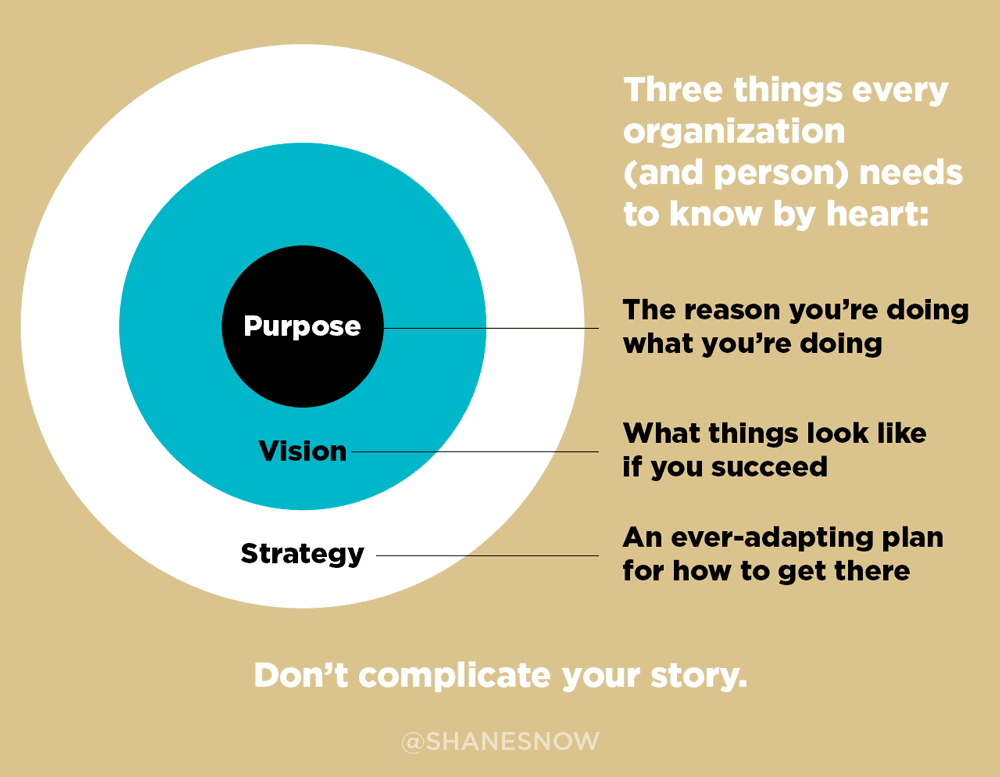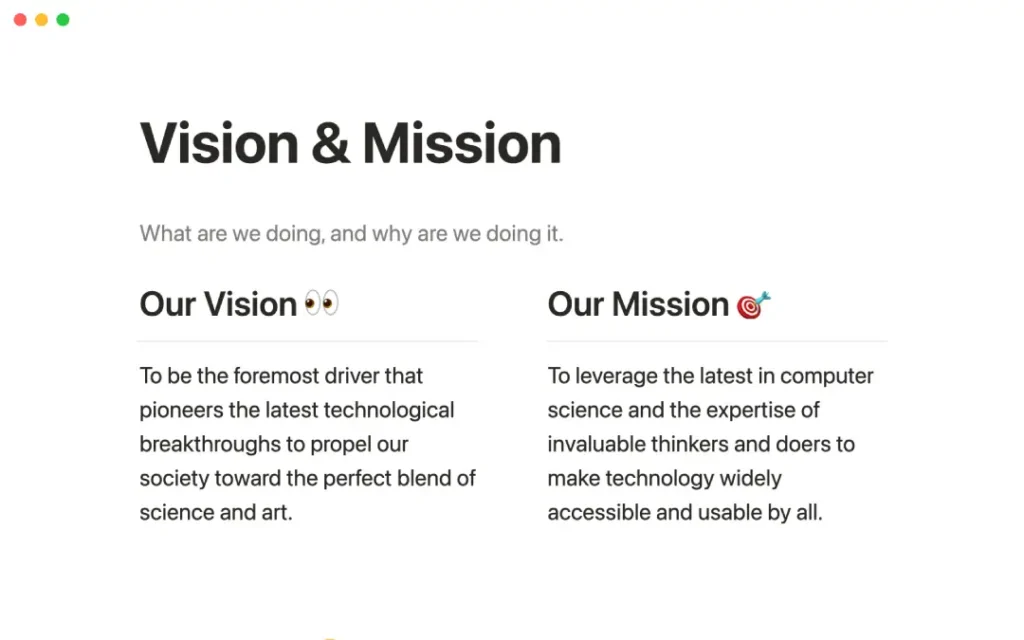How to Craft a Compelling Company Mission
Having a clear and inspiring company mission is more critical than ever.
It acts as a navigation that steers you through the ups and downs of business. But what is a company mission? And why does it matter so much?
Let’s jump right into this exciting subject.
- A clear company mission defines an organisation's purpose beyond profit, guiding decisions and aligning values.
- Mission statements inspire employees, creating a cohesive environment and enhancing motivation and productivity.
- Effective missions attract customers by resonating with their values, differentiating the brand in a competitive market.
What Is A Company Mission?

At its core, a company mission is a statement that defines why an entity exists. It represents the key drivers of an establishment other than making profits alone.
The big questions answered by your mission are: Why do we exist? What are our values? What kind of change do we want to bring to this world?
Consider the company’s soul or heartbeat; this is how significant I think about missions in businesses. All activities within your enterprise should be infused with life and purpose by it – from producing goods/services to serving customers well down through advertising plans!
The Difference Between Mission and Vision
You may ask yourself, “Wait a minute — isn’t that just a company vision?” Not precisely, though they are closely related.
The difference is this: A mission statement focuses on the present; it establishes what an organisation stands for and sets its core goals or objectives.
On the other hand, a vision statement looks forward into the future by outlining what a company hopes to accomplish or become. Simply put, your mission is what you’re doing presently, and your vision is where you want to go eventually.
Why Does a Company Mission Matter?
You may believe, “I think a mission statement is good, but can it do anything?” Yes! A strong company mission statement can have many profound effects on your business.
Directing Decision-Making
When you must make tough decisions (which happens almost daily in business), your organisation’s mission guides you. This keeps us on track with our fundamental purpose and values so that each choice corresponds with them.
Motivating Employees
An inspiring mission gives employees something they can unite around. It makes work feel like a calling and creates an environment where people know why they belong there.
When individuals believe their efforts contribute towards achieving larger goals, their levels of commitment increase considerably, thus making them more motivated and productive at work.
Winning Over Customers
In this era, when consumers are becoming more conscious about which companies deserve their support, a clear-cut corporate mission could set you apart from others who offer similar products or services. It enables you to connect with those buyers who share your beliefs and share in your vision.
Encouraging Creativity
The creativity and innovation within an organisation can be ignited by its mission’s ability to point out where effort should be concentrated at any given time in future endeavours for success achievement.
Doing so pushes teams beyond conventional thinking patterns towards coming up with unconventional ideas that still tie back into our core reasons for being here on earth as a company.
Constructing Brand Image
A carefully worded declaration acts as one cornerstone upon which brands are built because it tells people what kind of company we are and highlights what sets us apart from others offering similar goods/services in the marketplace – thus helping shape public perception about our identity and theirs.
The Anatomy of a Great Company Mission

Now that we have explained why a company mission is critical let’s discuss what creates a truly effective mission statement.
Clear and concise
Make your mission statement short and simple. The best one should be easy to understand and remember. It’s even better if your workers can recite it off head without checking.
Inspiring and aspirational
A good mission statement must spark enthusiasm in individuals. It should make them get up early every morning, ready to work towards your organisation’s goals.
Specific to your company
Do not use general phrases when drafting a mission statement. Let it speak for itself about what sets you apart from others within the same industry or sector you operate in but remain unique somehow – this way, it will also indirectly serve marketing purposes!
Impact-oriented
The more impactful your missions are, the better they become because powerful words never go unnoticed. This allows you to change their minds instantly just by reading such statements. They only answer one question: “How does this organisation improve people’s lives?”
Timeless
Strategies may change with time, but core missions should only deviate much from their original course if otherwise necessary, i.e., when more expansive space is needed due to growth or development.
However, these must always give clear directions while remaining flexible enough to accommodate any future adjustments that might be required to achieve desired objectives.
Examples of Powerful Company Missions
See examples of compelling company missions from the real world to see these principles in action.
Tesla
“To hasten the entire planet’s progress towards sustainable power.”
This mission is definite, to-the-point and outcome-oriented. It’s about electric cars and their broader appeal among eco-conscious consumers by expressing why they exist beyond them.
“To arrange all information across the globe and make it accessible universally.”
Google’s mission is enormous yet particular. It tells what the company does and what kind of effect it wants to create on Earth.
Patagonia
“We’re here to save our home planet.”
Bold and inspiring, this one-liner leaves no doubt about Patagonia’s commitment to environmental sustainability.
How to Craft Your Company Mission

Now that we have seen what makes a good company’s mission, let us discuss how you can create one for your business.
Begin with Your ‘Why’
Ask yourself why your company exists in the first place. What is the problem you are trying to solve? What difference are you attempting to make in this world? This is where every mission should be built from.
Engage Your Team
Do not create a mission alone. Involve your workers in developing it since they will work under this guidance daily. Their ideas matter a lot.
Keep It Simple
Always remember that it should be easy to understand and remember any statement regarding this direction. Avoid using jargon or complex terms while at it, too; if an average ten-year-old needs help to comprehend what has been written there, then chances are high that things will get too complicated somewhere along the line.
Be Real
Ensure that your objectives reflect the actual values and aspirations of the organisation. Do not try to sound nice – just tell people who you are and let them know what stands behind everything done by such a firm.
Try It Out
After drafting a mission statement, take some time and test it practically, speaking out loud! Share this document with all employees, including management, customers, and other stakeholders.
See how each person reacts towards different parts before settling on a final version based on feedback during the reshaping process.
Ultimately, we get the best possible outcome from everyone involved at every step taken toward realising corporate goals.
Bringing Your Company Mission to Life
Beginning with a mission statement is just the start. You know you’re onto something when bringing that mission into your day-to-day activities becomes challenging – and magical.
Communicate It
See to it that everyone within your organisation understands what the company stands for. Display it prominently in your office, website, and marketing materials.
Strategies That Are In Line With The Mission
Every business strategy or tactic should be aligned with the company’s objectives. If you are considering starting something new, ask yourself: does this support our mission?
Hire For Mission Fit
When recruiting new staff members, look out for those whose personal beliefs resonate with the organisation’s. They are likely to be more engaged and committed to achieving its success.
Mission-Aligned Metrics Measurement
Come up with key performance indicators (KPIs) that reflect how well you live by what your mission says, not just financial ones.
Celebrate Wins That Align With The Mission
Whenever someone on your team does anything which typifies what you stand for as an enterprise, celebrate! This will drive home not only the importance of such acts but also encourage others to do likewise in future.
Common Pitfalls in Creating a Company Mission

Even with the best intentions, businesses can sometimes get it wrong when establishing and implementing their mission. Here are a few common errors to avoid:
Being Vague
A good mission statement should not apply to every other company. Stating that “we want to be the best in our industry” does not explain what you do or believe in.
Focusing on Profit Only
A mission centred around making money will not motivate your team or connect with clients, even though profitability is crucial.
Forgetting About It Once Made
Your mission cannot be a “set it and forget it” thing. It has to be alive within your company culture – breathing and guiding decision-making at all levels.
Making It Too Long or Complicated
If people need a minute to go through your mission statement, it probably won’t stay at the top of their minds or touch their hearts.
Not Living by It
The most dangerous trap is failing at practising what one preaches. You lose credibility with employees and customers if your actions do not match the words in the organisation’s mission statement.
The Evolution of Company Missions
Companies’ missions are not fixed; they can and should change as a business expands and the world develops. Let’s trace the history of company missions.
From Profit to Purpose
Traditionally, most companies considered their mission to be to maximise shareholder value. However, this has changed with time because businesses are now supposed to be responsible for all stakeholders, such as employees, customers, communities and the natural ecosystem.
The Growth in Social Responsibility
Many businesses now include social and environmental responsibility within their missions due to shifting consumer expectations and recognising corporations’ broader societal role.
Mission-Driven Startups
There is a new breed of startups that begin with an explicit social or environmental goal in mind right from day one. These “mission-native” firms tend to attract enthusiastic staff and committed clients who share similar values.
Measuring the Impact of Your Company Mission

How can you tell if your company mission is having an impact? Here are a few ways to measure its influence:
Employee engagement surveys
Regular surveys can help you assess whether or not your employees understand and connect with the mission.
Customer feedback
Listen to what people are saying about your brand. Are they talking about the mission or values? This can show how effectively you communicate and live up to it.
Mission-aligned KPIs
Create specific metrics tied to the mission. For instance, if sustainability is part of what drives you, then track your carbon footprint or % of recycled materials in products used.
Brand perception studies
Use market research techniques to discover how customers see you through your mission statement/ethos. What do they know you for?
Financial performance
Though profit alone isn’t everything, a well-executed mission should ultimately pay off monetarily. Consider inconsideration between business outcomes and undertaking initiatives that align with the organisation’s purpose.
The Future of Company Missions
In terms of the future, what can we expect to be the different company missions?
Enhanced Attention on Sustainability
One of the things that might change as more and more people become conscious of climate change and other environmental problems is that many companies will start making sustainability their primary goal.
Diversity and Inclusion Matter More Than Ever
A lot of businesses have realised that diversity is just as important to them as it is suitable for everyone else in society – not only because they want to do what’s best but also because having different perspectives helps give birth to new ideas, which then leads us closer towards achieving success.
Another trend reflected in mission statements across various organisations will involve inclusion within them, too!
Technology with an Ethical Edge
Technology will continue shaping our lives; thus, more tech companies may outline missions concerning solving global challenges through ethically utilising technological advancements.
Considering Everyone Involved
We’re also likely to see a shift towards businesses adopting objectives catering to all stakeholders’ needs instead of just those who hold shares in these enterprises.
Conclusion: Your Mission, Should You Choose to Accept It
Creating a captivating corporate mission is difficult, but it’s a task that can significantly affect your enterprise. It isn’t only words on paper; it means determining who you are as an organisation and what changes you want to bring about.
Keep in mind that your mission is the purpose of your company. This is the energy behind your team members, the commitment to your clients and the footprint you desire to make globally. So do not rush over it. Inspire colleagues, contemplate upon values and let yourself imagine big.
Ultimately, an impactful company mission goes beyond what one does – it also answers why they do so. And with a strong ‘why’, there are no boundaries to success.
FAQs About Company Missions
How frequently should we assess the goal of our company?
Every year, it is advisable to review and ensure that your mission still reflects the direction and values of your organisation. However, for consistency, you should keep your mission the same.
Can a company have multiple missions?
While a business can have several aims or objectives, it is better to have one main goal covering all the others. This will help maintain focus and clarity.
How long should a mission statement be?
Ideally, a mission statement should be short enough to remember easily – usually one to three sentences. However, the length doesn’t matter much as long as what has been written is clear and of good quality.
Should our mission statement mention our products or services?
Not necessarily. Your aim must be more concerned about what impact you want to create rather than how specific things are done to achieve this objective. It allows for flexibility when your products or services change over time.
How can we ensure that employees adopt our company’s goals?
To make workers embrace these targets, communicate regularly with them, lead through personal example setting, and integrate such an idea into daily operations and decision-making processes.
Is it okay to change our company mission?
Yes, but only refine or evolve while keeping the core purpose intact because stability matters here; growth may happen at any given moment in businesses, thus leading organisations to change their missions frequently without informing stakeholders clearly about such moves.
How does a company mission differ from company values?
Mission refers to why you exist, while values guide behaviour during its pursuit.
Can a company mission statement be too ambitious?
No, though being achievable matters most, you should always strike between being realistic and inspiring others towards achievement.
Should we include our mission statement in job postings?
Definitely! Posting your missions on job sites can attract candidates who share the same values with your organisation.
How can we measure if we’re living up to our mission?
Create specific, measurable objectives that align with them, then monitor progress frequently against such benchmarks, but remember that feedback from employees and customers also counts.

